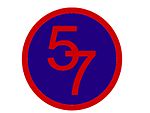| No. 57 Squadron RAF | |
|---|---|
 57 Squadron crest | |
| Active |
8 June 1916 – 2002 2008 – |
| Country | United Kingdom |
| Branch | Royal Air Force |
| Motto(s) |
Corpus non animum muto Latin: I change my body not my spirit |
| Battle honours | Western Front, 1916–1918: Amiens, France & Low Countries, 1939–1940: Norway, 1940: Channel & North Sea, 1940: Ruhr, 1941–1943: Fortress Europe, 1941–1944: Berlin, 1941–1943: Walcheren, France & Germany, 1944–1945: South Atlantic 1982. |
No. 57 Squadron RAF is a Royal Air Force flying training squadron.
History[]
World War I[]
57 Squadron of the Royal Flying Corps was formed on 8 June 1916 at Copmanthorpe, Yorkshire. In December 1916 the squadron was posted to France equipped with the FE2d. The squadron re-equipped with Airco DH4s in May 1917 and commenced long range bombing and reconnaissance operations near Ypres in June of that year.[citation needed] It was one of the few bomber units to produce flying aces, having five on strength. William Edward Green scored nine wins,[1] James Grant[2] and Forde Leathley eight,[3] E. Graham Joy seven (plus one later in 205 Squadron),[4] and Arthur Thomas Drinkwater scored six, all in Airco DH.4s.[5]
Between the Wars[]
Following the armistice the squadron was assigned to mail carrying duties before returning to the UK in August 1919 and then disbanding on 31 December of that year.[citation needed] The squadron re-formed at Netheravon on 20 October 1931 equipped with the Hawker Hart. In May 1936 the squadron converted to the Hawker Hind.
World War II[]


At the outbreak of war the squadron was based in France equipped with Bristol Blenheims and was engaged in bombing and reconnaissance operations during the German invasion. The squadron operated from Rosièresdisambiguation needed, then Poix and finally Crécy before returning to England in May 1940. After a brief stay at Wyton the squadron moved to Scotland to commence anti-shipping strikes against the coast of Norway.
The squadron moved to Feltwell in November 1940 to re-equip with the Vickers Wellington. In September 1942 the squadron moved to Scampton and converted to Avro Lancasters. This was followed by a move to East Kirkby in August 1943 from where it operated for the remainder of the war until disbanding on 25 November 1945.
Modern era[]
The following day the squadron was re-formed via the re-numbering of No. 103 Squadron's Avro Lincoln flight.
In May 1951 the squadron converted to Boeing Washingtons before re-equipping with the English Electric Canberra in May 1953. The squadron disbanded on 9 December 1957.
The squadron re-formed on 1 January 1959 at Honington as part of the V bomber force equipped with the Handley Page Victor. In December 1965 the squadron moved to Marham to take on the role of a tanker squadron, before disbanding again on 30 June 1986.
The squadron number was assigned to No. 242 OCU at Lyneham from 1 June 1992 until 14 March 2002.
The 57 Squadron plate was assigned to No. 2 Sqn, 1 EFTS as an elementary flying training squadron, this was effective from 1 October 2008.
Aircraft operated[]
| Dates | Aircraft | Variant | Notes |
|---|---|---|---|
| 1916 | Royal Aircraft Factory B.E.2 | BE2c | |
| 1916 | Avro 504 | 504K | |
| 1916–1917 | Royal Aircraft Factory F.E.2 | FE2d | |
| 1917–1919 | Airco DH.4 | ||
| 1919 | de Havilland DH.9 | DH.9A | |
| 1931–1936 | Hawker Hart | ||
| 1936–1938 | Hawker Hind | ||
| 1938–1940 | Bristol Blenheim | I | |
| 1940 | Bristol Blenheim | IV | |
| 1940–1942 | Vickers Wellington | IA, IC, II and III | |
| 1942–1946 | Avro Lancaster | I & III | |
| 1945–1951 | Avro Lincoln | B2 | |
| 1951–1953 | Boeing Washington | B1 | |
| 1953–1957 | English Electric Canberra | B2 | |
| 1959–1966 | Handley Page Victor | B1 | |
| 1966–1977 | Handley Page Victor | K1 | |
| 1976–1986 | Handley Page Victor | K2 | |
| 1992–2002 | Lockheed Hercules | ||
| 2008- | Grob Tutor | T1 |
See also[]
- Alfie Fripp, longest serving and last surviving British prisoner of war
- List of Royal Air Force aircraft squadrons
- 57 & 630 Squadrons' Association Website: [1]
Endnotes[]
References[]
- Franks, Norman; Guest, Russell; Alegi, Gregory. Above the War Fronts: the British Two-seater Bomber Pilot and Observer Aces, the British Two-seater Fighter Observer Aces, and the Belgian, Italian, Austro-Hungarian and Russian Fighter Aces, 1914-1918: Volume 4 of Fighting Airmen of WWI Series: Volume 4 of Air Aces of WWI. Grub Street, 1997. ISBN 1-898697-56-6, ISBN 978-1-898697-56-5.
- http://www.raf.mod.uk/bombercommand/h57.html
- http://www.rafweb.org/Sqn056-60.htm
- G G Jefford, RAF Squadrons, second edition 2001, Airlife Publishing, UK, ISBN 1-84037-141-2.
External links[]
| Wikimedia Commons has media related to No. 57 Squadron RAF. |
The original article can be found at No. 57 Squadron RAF and the edit history here.